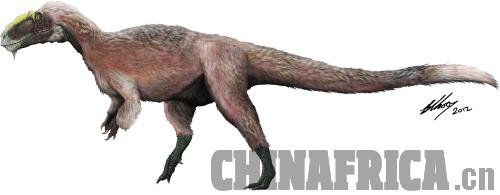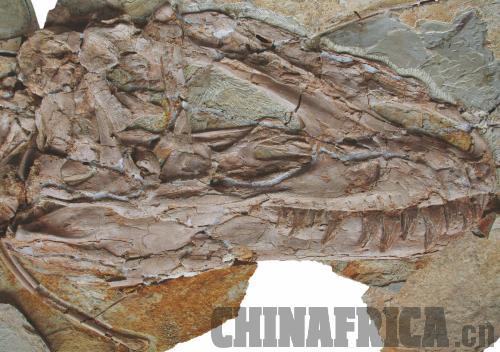|
 |
|
SCIENTISTS' IMAGINATION: A painting of Yutyrannus huali shows that its huge body is covered by feathers (BRAIN CHOO) |
The next time people see an adventure sci-fi movie like Hollywood's Jurassic Park, dinosaurs in the movie may look very different, especially the Tyrannosaurus rex. They could be feathered.
Recently, paleontologists discovered fossils of a new tyrannosauroid species from the Middle-Upper Jurassic and Lower Cretaceous deposits of northeast China's Liaoning Province. Three specimens of this new Tyrannosaurus recovered by scientists show that at least one kind of much larger dinosaur had a feathery coat.
Scientists have named the new species, Yutyrannus huali, which means "beautiful feathered tyrant" in a combination of Latin and Chinese. The bus-sized Tyrannosaurus is the largest feathered animal ever found.
Xu Xing, the lead scientist of the study and researcher at the Beijing-based Institute of Vertebrate Paleontology and Paleoanthropology at the Chinese Academy of Sciences (CAS), said in a statement, "It was possible that feathers were much more widespread, at least among carnivorous dinosaurs, than most scientists would have imagined even a few years ago." The new finding was reported by Chinese and Canadian scientists in the journal Nature on April 4, 2012.
 |
|
NEW FINDING: A fossil of the skull of Yutyrannus huali is found in west Liaoning Province (ZANG HAILONG) |
Why feathered?
For more than a decade, scientists have known that some dinosaur species had bird-like feathers through fossils discovered around the world, but most of them were small ones. Therefore, scientists previously thought feathers only grew on small dinosaurs.
It is the first time that scientists have found feathers on large predators like the Tyrannosaurus. The team found three specimens of Yutyrannus huali - an adult and two juveniles. The adult was at least 30 feet long and weighed 1.5 tons, about 40 times the heft of Beipiaosaurus, the largest previously known feathered dinosaur. The two juveniles were a mere half ton each.
"The feathers of Yutyrannus huali were simple filaments," explained Xu. "They were more like the fuzzy down of a little chicken than the stiff plumes of an adult bird."
Due to the large size and heavy weight, it was impossible for Yutyrannus huali to fly with the fuzzy feathers. So why did the large predator have feathers?
Through an oxygen isotope analysis on the teeth fossils, researchers found that the Lower Cretaceous was much colder than other periods of the Cretaceous. For this reason, dinosaurs like Yutyrannus grew feathers to keep warm from the cold weather.
"The idea that primitive feathers could have been for insulation rather than flight has been around for a long time," said Corwin Sullivan, a Canadian paleontologist who participated in the study. "However, large-bodied animals typically can retain heat quite easily, and actually have more of a potential problem with overheating. That makes Yutyrannus, which was large and downright shaggy, a bit of a surprise."
About 125 million years ago, when Yutyrannus lived, the climate in some areas of the Earth might have turned cold. Scientists estimated that the west Liaoning Province in that ancient time might be as cold as it is now. Yutyrannus living in that period might have had to grow feathers to maintain its body temperature.
|